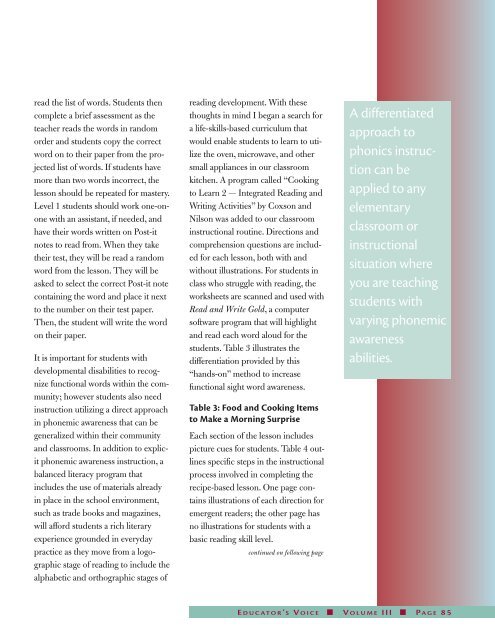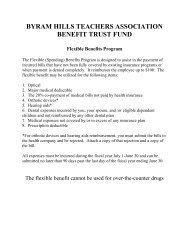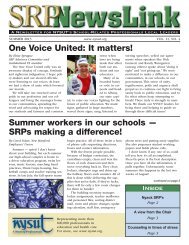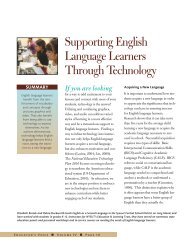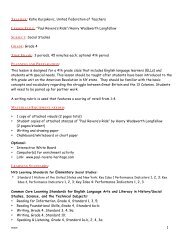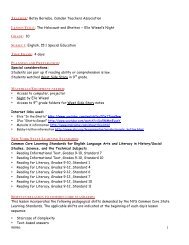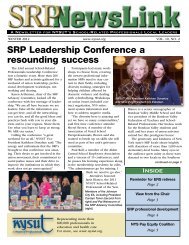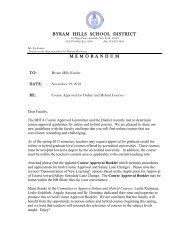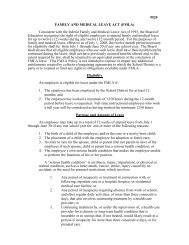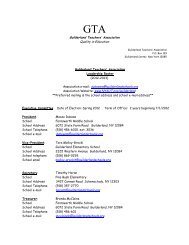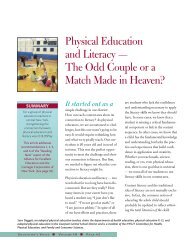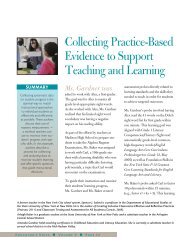Functional Literacy in a Life Skills Curriculum - NYSUT
Functional Literacy in a Life Skills Curriculum - NYSUT
Functional Literacy in a Life Skills Curriculum - NYSUT
You also want an ePaper? Increase the reach of your titles
YUMPU automatically turns print PDFs into web optimized ePapers that Google loves.
ead the list of words. Students then<br />
complete a brief assessment as the<br />
teacher reads the words <strong>in</strong> random<br />
order and students copy the correct<br />
word on to their paper from the projected<br />
list of words. If students have<br />
more than two words <strong>in</strong>correct, the<br />
lesson should be repeated for mastery.<br />
Level 1 students should work one-onone<br />
with an assistant, if needed, and<br />
have their words written on Post-it<br />
notes to read from. When they take<br />
their test, they will be read a random<br />
word from the lesson. They will be<br />
asked to select the correct Post-it note<br />
conta<strong>in</strong><strong>in</strong>g the word and place it next<br />
to the number on their test paper.<br />
Then, the student will write the word<br />
on their paper.<br />
It is important for students with<br />
developmental disabilities to recognize<br />
functional words with<strong>in</strong> the community;<br />
however students also need<br />
<strong>in</strong>struction utiliz<strong>in</strong>g a direct approach<br />
<strong>in</strong> phonemic awareness that can be<br />
generalized with<strong>in</strong> their community<br />
and classrooms. In addition to explicit<br />
phonemic awareness <strong>in</strong>struction, a<br />
balanced literacy program that<br />
<strong>in</strong>cludes the use of materials already<br />
<strong>in</strong> place <strong>in</strong> the school environment,<br />
such as trade books and magaz<strong>in</strong>es,<br />
will afford students a rich literary<br />
experience grounded <strong>in</strong> everyday<br />
practice as they move from a logographic<br />
stage of read<strong>in</strong>g to <strong>in</strong>clude the<br />
alphabetic and orthographic stages of<br />
read<strong>in</strong>g development. With these<br />
thoughts <strong>in</strong> m<strong>in</strong>d I began a search for<br />
a life-skills-based curriculum that<br />
would enable students to learn to utilize<br />
the oven, microwave, and other<br />
small appliances <strong>in</strong> our classroom<br />
kitchen. A program called “Cook<strong>in</strong>g<br />
to Learn 2 — Integrated Read<strong>in</strong>g and<br />
Writ<strong>in</strong>g Activities” by Coxson and<br />
Nilson was added to our classroom<br />
<strong>in</strong>structional rout<strong>in</strong>e. Directions and<br />
comprehension questions are <strong>in</strong>cluded<br />
for each lesson, both with and<br />
without illustrations. For students <strong>in</strong><br />
class who struggle with read<strong>in</strong>g, the<br />
worksheets are scanned and used with<br />
Read and Write Gold, a computer<br />
software program that will highlight<br />
and read each word aloud for the<br />
students. Table 3 illustrates the<br />
differentiation provided by this<br />
“hands-on” method to <strong>in</strong>crease<br />
functional sight word awareness.<br />
Table 3: Food and Cook<strong>in</strong>g Items<br />
to Make a Morn<strong>in</strong>g Surprise<br />
Each section of the lesson <strong>in</strong>cludes<br />
picture cues for students. Table 4 outl<strong>in</strong>es<br />
specific steps <strong>in</strong> the <strong>in</strong>structional<br />
process <strong>in</strong>volved <strong>in</strong> complet<strong>in</strong>g the<br />
recipe-based lesson. One page conta<strong>in</strong>s<br />
illustrations of each direction for<br />
emergent readers; the other page has<br />
no illustrations for students with a<br />
basic read<strong>in</strong>g skill level.<br />
cont<strong>in</strong>ued on follow<strong>in</strong>g page<br />
A differentiated<br />
approach to<br />
phonics <strong>in</strong>struction<br />
can be<br />
applied to any<br />
elementary<br />
classroom or<br />
<strong>in</strong>structional<br />
situation where<br />
you are teach<strong>in</strong>g<br />
students with<br />
vary<strong>in</strong>g phonemic<br />
awareness<br />
abilities.<br />
E D U C A T O R ’ S V O I C E n V O L U M E I I I n P A G E 8 5


